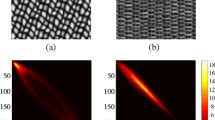Abstract
Texture analysis is an important technique in many image processing areas, such as scene segmentation, object recognition, and shape&depth perception. However, most methods are restricted to issue of computational complexity and supervised problems. Accordingly, we propose a efficient method of segmenting texture that uses unsupervised learning schemes to discover a texture cluster without a pre-knowledge. This method applies 2D Gaussian filters to the clustered region iteratively, and the thresholding value for segmenting is automatically determined by analyzing histogram of the clustered inner-region. It can be acquired by the boundary tracing in the clustered region. In order to show the performance of the proposed method, we have attempted to build a various texture images, and the segmenting quality was measured according to the goodness based on the segmented shape of region. Our experimental results showed that the performance of the proposed method is very successful.
Preview
Unable to display preview. Download preview PDF.
Similar content being viewed by others
References
Randen, T., Husoy, J.: Filtering for texure classification: A Comparative study. IEEE Trans. PAMI 21, 291–310 (1999)
Idrissa, M., Acheroy, M.: Texture classification using Gabor filters. Pattern Recognition Letters 23, 1095–1102 (2002)
Tsai, D., et al.: Optimal Gabor filter design for texture segmentation using stochastic optimazation. Image and Vision Computing 19, 299–316 (2001)
Grigorescu, S., et al.: Comparesion of Texture Feature Based on Gabor Filters. IEEE Trans. Image Precessing 11, 1160–1167 (2002)
Marr, D.: Vision A Computational Investigation into the Human Representation and Processing of Visual Information. W. H. Freeman & Company, New York (1982)
Kohonen, T.: The self-organizing map. Proc. IEEE 78, 1464–1480 (1990)
Sonka, M., et al.: Image Processing. Analysis, and Machine Vision 2th, PWS (1999)
Brodatz, P.: Texture A Photographic Album for Artists and Designer. Dover (1966)
Author information
Authors and Affiliations
Editor information
Editors and Affiliations
Rights and permissions
Copyright information
© 2005 Springer-Verlag Berlin Heidelberg
About this paper
Cite this paper
Lee, W., Kim, W. (2005). Texture Segmentation by Unsupervised Learning and Histogram Analysis Using Boundary Tracing. In: Hao, Y., et al. Computational Intelligence and Security. CIS 2005. Lecture Notes in Computer Science(), vol 3801. Springer, Berlin, Heidelberg. https://doi.org/10.1007/11596448_4
Download citation
DOI: https://doi.org/10.1007/11596448_4
Publisher Name: Springer, Berlin, Heidelberg
Print ISBN: 978-3-540-30818-8
Online ISBN: 978-3-540-31599-5
eBook Packages: Computer ScienceComputer Science (R0)




